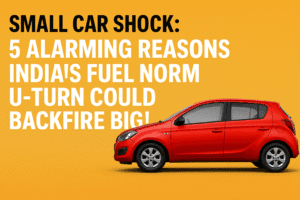Small Car Shock: 5 Alarming Reasons India’s Fuel Norm U-Turn Could Backfire Big!
India weighs relaxing fuel efficiency rules for cars under 1,000kg following intense lobbying by Maruti Suzuki, whose small car sales have plummeted 18% over two years amid an SUV boom. The government, concerned about declining affordable car sales and broader market growth, sees merit in giving smaller vehicles more leeway under Corporate Average Fuel Efficiency (CAFE) norms. This would ease pressure on Maruti (with 10 lightweight models) to rapidly electrify its struggling core segment.
However, the move faces strong industry backlash as competitors argue it abandons a prior consensus for uniform standards, unfairly advantages Maruti, and undermines India’s environmental goals. Critics contend it distorts the market for firms investing in larger vehicles or electrification, while proponents cite smaller cars’ inherent resource efficiency. The debate pits preserving vital affordable mobility and jobs against the imperative for cleaner technology progress. India’s final decision will reveal its priority: immediate relief for a dominant player or maintaining consistent regulatory pressure for efficiency.

Small Car Shock: 5 Alarming Reasons India’s Fuel Norm U-Turn Could Backfire Big!
India’s automotive landscape, long dominated by compact, affordable hatchbacks, is facing a pivotal moment. As Reuters reports, the Indian government is actively considering a significant relaxation of fuel efficiency (CAFE – Corporate Average Fuel Efficiency) norms specifically for cars weighing under 1,000 kg – a move driven by intense lobbying from market leader Maruti Suzuki and reflecting deep concerns about the declining health of the small car segment.
The Shifting Tides: Small Cars Losing Ground
Maruti Suzuki, synonymous with India’s small car revolution (models like Alto, Wagon R, Swift), has seen a dramatic reversal of fortune. Once constituting nearly two-thirds of its sales, small cars now make up less than half of its annual volume (down to under 50% of 1.7 million units). This precipitous 18% drop over just two years mirrors a broader industry trend: the relentless surge of SUV popularity. Consumers increasingly favour larger, feature-rich SUVs, leaving the traditional budget hatchback feeling neglected.
The Pressure Point: Stricter Norms vs. Declining Sales
Enter the CAFE regulations. These rules link permissible CO2 emissions to a vehicle’s weight. To meet increasingly stringent targets and avoid penalties, manufacturers must sell a growing percentage of ultra-low emission vehicles, primarily electric cars (EVs). For Maruti, heavily reliant on small internal combustion engine (ICE) cars, meeting these targets without drastically increasing EV sales (which currently form a small part of its portfolio) is becoming economically challenging amidst falling demand for its core products.
The Proposed Lifeline: Easier Rules for the Smallest
The government’s solution, reportedly under serious consideration, is to ease the CAFE limits specifically for vehicles under 1,000 kg. This would:
- Reduce Electrification Pressure: Carmakers selling sub-1,000 kg vehicles would face less stringent requirements to offset emissions through EV sales. This directly benefits companies heavily invested in small ICE cars.
- Boost Maruti Significantly: With 10 of its 17 current models falling below this weight threshold, Maruti Suzuki stands to gain disproportionately. Other players like Hyundai, Renault, Toyota, MG Motor, and Tata also have models in this category, but none rely on them as fundamentally as Maruti does.
- Address Government Concerns: A senior official acknowledged alignment with Maruti’s argument, stating, “There should be more benefit for small cars… we agree.” The government fears the collapse of the affordable entry-level segment could stall overall passenger vehicle market growth and impact employment in the vast ecosystem supporting small car manufacturing.
The Industry Backlash: A Fractured Consensus
However, this potential carve-out is far from universally welcomed:
- Level Playing Field Abandoned? Multiple sources indicate that creating a separate, easier standard for small cars represents a sharp departure from previous industry-government consultations, where a uniform weight-based standard was the understood approach. Months of talks seemingly never raised this specific bifurcation.
- Unfair Advantage: Competitors like Tata Motors, Mahindra & Mahindra, and Volkswagen – who have invested heavily in larger vehicles and/or electrification strategies – perceive this as giving Maruti an undue regulatory advantage. They argue it distorts the market and penalizes companies focusing on different segments or cleaner technologies.
- Environmental Concerns: Critics argue relaxing standards for any segment, regardless of size, undermines India’s climate goals and air quality efforts. Suzuki’s counterpoint, highlighted in a sustainability report, is that small cars inherently use fewer resources to build and operate, offering environmental benefits beyond tailpipe emissions. However, easing efficiency norms directly counteracts part of this advantage.
The Core Tension: Survival vs. Progress
This debate cuts to the heart of a complex challenge:
- Economic & Social Reality: Small, affordable cars remain crucial for millions of first-time buyers and middle-class families. Their potential demise has significant economic ripple effects.
- Environmental Imperative: India has committed to ambitious carbon reduction targets. Continuously relaxing efficiency standards, even for a struggling segment, moves the country away from those goals.
- Market Dynamics vs. Regulation: Should regulation actively prop up a segment losing consumer favour, potentially delaying its necessary evolution (like electrification), to protect incumbent players?
The Road Ahead: A Defining Choice
The government’s final decision on the CAFE norms for 2027 will be highly consequential. Relaxing rules for small cars may offer Maruti and the segment a temporary reprieve, potentially stabilizing sales and preserving jobs. However, it risks:
- Creating a two-tier regulatory system resented by much of the industry.
- Slowing down the pace of efficiency improvements and electrification precisely in the segment where lightweight EVs could have the greatest efficiency and affordability potential.
- Setting a precedent where regulatory frameworks bend to accommodate the struggles of dominant players.
India stands at a crossroads: balancing the urgent need to preserve affordable mobility and a vital industry segment against the uncompromising necessity of environmental progress and technological evolution. The choice made will resonate far beyond Maruti Suzuki’s showrooms.
You must be logged in to post a comment.